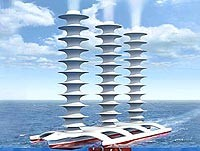Resisting the Dangerous Allure of Global Warming Technofixes

Yale.360 In the summer of 2006,
geoengineering - the radical proposal to offset one human
intervention into planetary systems with another - came roaring out
of the scientific closet. Deliberate climate modification, as
climate scientist Wally Broecker once noted, had long been “one of
the few subjects considered taboo in the realm of scientific
inquiry.”
Two things spurred this dramatic reversal: growing alarm because
climate change was hitting harder and faster than expected and the
abysmal failure of political efforts to reduce carbon dioxide
emissions. Indeed, since world leaders signed the Rio Convention on
Climate Change in 1992, global emissions climbed from 6.1 billion
metric tons of carbon a year to 8.5 billion tons in 2007.
Dismayed by the inaction, Paul Crutzen, a Nobel laureate,
target=”_blank”>published a controversial paper in August,
2006 that opened the door to the hitherto unthinkable. Since timely
and sufficient reductions appeared to be, in his words, “a pious
wish,” he urged serious investigation of technological proposals to
offset rising temperatures.
For some, geoengineering seemed to hold out another hope: that
technology might provide an escape not only from growing heat, but
also from the thorny realm of hard choices and difficult
international politics. Those politics were on vivid display
target=”_blank”>in Copenhagen this week, as nations have agreed
on the gravity of the threat but little else.
Since the release of Crutzen’s influential paper, many have voiced
concerns about possible hazards posed by geoengineering schemes.
For example, the artificial volcano projects, which would inject
sulfate particles into the stratosphere to deflect incoming
sunlight, might reduce the symptom of excess heat, but experience
from past volcanic eruptions and climate models indicates that this
approach would likely alter rainfall patterns and intensify drought
in many regions. The moral and political hazards of
geoengineering are as formidable as the physical dangers.
And because such sunshade schemes only treat a symptom rather
than tackle the cause, this technofix would do nothing to prevent
another dire consequence of rising levels of carbon dioxide in the
atmosphere - increasing acidity in ocean waters. This acidity
jeopardizes coral reefs, shelled marine life, and a tiny plankton
Emiliania huxleyi, which plays a key role in the transfer
of carbon from the atmosphere to long-term storage in deep ocean
sediments.
But the biggest hitch in sunshade remedies involves politics and
questions of governance, for they would require an unflagging
commitment of centuries: five hundred years or so, or, if we do not
make major emissions cuts, even as long as a millennium. If
anything were to interrupt this geoengineering effort, which would
have to keep replenishing the sulfates every few years, the world
would quickly confront a doomsday scenario: Temperatures would
suddenly soar upward at a rate 20 times faster than they are rising
today, causing unimaginable havoc in human and natural systems and
with it, the real danger of human extinction. This institutional
challenge is without question a far greater obstacle than any
technological difficulties. It is hard to imagine that anyone with
even a passing knowledge of human history would think this
long-term commitment could be a prudent gamble.
The moral and political hazards of geoengineering are altogether as
formidable as the physical dangers. However inviting the prospects
shimmering on the technological horizon, geoengineering “solutions”
and the promise of a technofix down the road lead us easily into
temptation. Indeed, these speculative technologies are already
figuring in the political debate and hover in the background of
diplomatic discussions, since it will be impossible to limit future
warming to 2 degrees C, as G-8 leaders pledged in July, without
something like a new technology to suck carbon dioxide from the
atmosphere. It is easy to forget that these are proposals, not
proven technologies. There is no assurance that any will actually
work as imagined.
Source: by Dianne Dumanoski www.e360.yale.edu
You can return to the main Market News page, or press the Back button on your browser.

